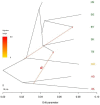Genome-Wide Single-Nucleotide Polymorphism Data Unveil Admixture of Chinese Indigenous Chicken Breeds with Commercial Breeds
- PMID: 31263886
- PMCID: PMC6609729
- DOI: 10.1093/gbe/evz128
Genome-Wide Single-Nucleotide Polymorphism Data Unveil Admixture of Chinese Indigenous Chicken Breeds with Commercial Breeds
Abstract
The conservation and development of chicken have received considerable attention, but the admixture history of chicken breeds, especially Chinese indigenous breeds, has been poorly demonstrated. In this study, we aimed to evaluate the genetic diversity and population structure of eight chicken breeds (including conserved chicken breeds) from different geographic origin and to identify admixture within these breeds using a 600-K single-nucleotide polymorphism panel for genotyping. Using the genotype of 580,961 single-nucleotide polymorphism markers scored in 1,200 animals, we evaluated the genetic diversity (heterozygosity and proportion of polymorphic markers), linkage disequilibrium decay, population structure (principal component analysis and neighbor-joining tree), genetic differentiation (FST and genetic distance), and migration events (TreeMix and f-statistics) of the eight domesticated chicken breeds. The results of population analytical methods revealed patterns of hybridization that occurred after divergence in Tibetan chicken. We argue that chicken migration and admixture, followed by trade, have been important forces in shaping the genomic variation in modern Chinese chicken. Moreover, isolation by distance might play a critical role in shaping the genomic variation within Eurasia continent chicken breeds. Moreover, genetic information provided in this study is valuable resources for production applications (genomic prediction, and breeding strategy) and scientific research (genetic basis detection, studying evolution, or domestication).
Keywords: Chinese indigenous chicken; admixture; genetic diversity; genome-wide single-nucleotide polymorphism; population structure.
© The Author(s) 2019. Published by Oxford University Press on behalf of the Society for Molecular Biology and Evolution.
Figures



Similar articles
-
Analysis of genetic diversity and genetic structure of indigenous chicken populations in Guizhou province based on genome-wide single nucleotide polymorphism markers.Poult Sci. 2024 Dec;103(12):104383. doi: 10.1016/j.psj.2024.104383. Epub 2024 Oct 5. Poult Sci. 2024. PMID: 39447329 Free PMC article.
-
Genome-wide assessment of genetic diversity and population structure insights into admixture and introgression in Chinese indigenous cattle.BMC Genet. 2018 Dec 20;19(1):114. doi: 10.1186/s12863-018-0705-9. BMC Genet. 2018. PMID: 30572824 Free PMC article.
-
The SYNBREED chicken diversity panel: a global resource to assess chicken diversity at high genomic resolution.BMC Genomics. 2019 May 7;20(1):345. doi: 10.1186/s12864-019-5727-9. BMC Genomics. 2019. PMID: 31064348 Free PMC article.
-
South African indigenous chickens' genetic diversity, and the adoption of ecological niche modelling and landscape genomics as strategic conservation techniques.Poult Sci. 2025 Jan;104(1):104508. doi: 10.1016/j.psj.2024.104508. Epub 2024 Nov 6. Poult Sci. 2025. PMID: 39657468 Free PMC article. Review.
-
Morphological diversity of integumentary traits in fowl domestication: Insights from disparity analysis and embryonic development.Dev Dyn. 2019 Nov;248(11):1044-1058. doi: 10.1002/dvdy.105. Epub 2019 Sep 13. Dev Dyn. 2019. PMID: 31433887 Review.
Cited by
-
Variations in BCO2 Coding Sequence Causing a Difference in Carotenoid Concentration in the Skin of Chinese Indigenous Chicken.Genes (Basel). 2023 Mar 8;14(3):671. doi: 10.3390/genes14030671. Genes (Basel). 2023. PMID: 36980942 Free PMC article.
-
Analysis of genetic diversity and genetic structure of indigenous chicken populations in Guizhou province based on genome-wide single nucleotide polymorphism markers.Poult Sci. 2024 Dec;103(12):104383. doi: 10.1016/j.psj.2024.104383. Epub 2024 Oct 5. Poult Sci. 2024. PMID: 39447329 Free PMC article.
-
High-density single nucleotide polymorphism markers reveal the population structure of 2 local chicken genetic resources.Poult Sci. 2023 Jul;102(7):102692. doi: 10.1016/j.psj.2023.102692. Epub 2023 Apr 5. Poult Sci. 2023. PMID: 37120867 Free PMC article.
-
Decoding the fibromelanosis locus complex chromosomal rearrangement of black-bone chicken: genetic differentiation, selective sweeps and protein-coding changes in Kadaknath chicken.Front Genet. 2023 Jun 22;14:1180658. doi: 10.3389/fgene.2023.1180658. eCollection 2023. Front Genet. 2023. PMID: 37424723 Free PMC article.
-
Origins, timing and introgression of domestic geese revealed by whole genome data.J Anim Sci Biotechnol. 2023 Feb 13;14(1):26. doi: 10.1186/s40104-022-00826-9. J Anim Sci Biotechnol. 2023. PMID: 36782272 Free PMC article.
References
-
- Azimu W, et al. 2018. Genetic diversity and population structure analysis of eight local chicken breeds of Southern Xinjiang. Br Poult Sci. 59(6):629–635. - PubMed
-
- Bagust TJ. 1994. Improving health for poultry production in Asia: a developmental perspective. Avian Pathol. 23(3):395–404. - PubMed
-
- Bay RA, et al. 2018. Genomic signals of selection predict climate-driven population declines in a migratory bird. Science 359(6371):83–86. - PubMed
Publication types
MeSH terms
LinkOut - more resources
Full Text Sources
Molecular Biology Databases
Miscellaneous

